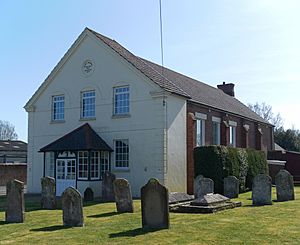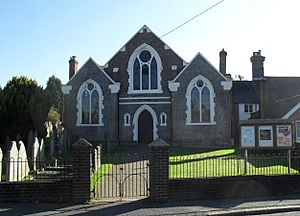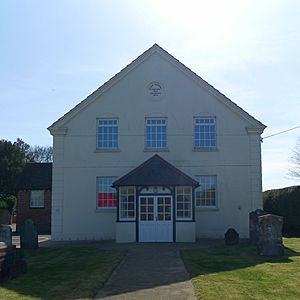Zoar Strict Baptist Chapel facts for kids
Quick facts for kids Zoar Strict Baptist Chapel |
|
|---|---|

The chapel from the northwest
|
|
| 50°52′44″N 0°13′37″E / 50.8790°N 0.2270°E | |
| Location | A22, Lower Dicker, near Hailsham, East Sussex BN27 4AT |
| Country | England |
| Denomination | Baptist |
| Tradition | Strict Baptist |
| History | |
| Former name(s) | The Dicker Chapel |
| Status | Chapel |
| Founded | 1837 |
| Founder(s) | William Cowper |
| Architecture | |
| Functional status | Active |
| Style | Classical/Georgian |
| Groundbreaking | 1837 |
| Completed | 1838 |
| Construction cost | £422 |
Zoar Strict Baptist Chapel is a special church building in a small village called Lower Dicker in East Sussex, England. It's a place of worship for a group of Christians known as Strict Baptists.
This large and impressive building was first opened in 1837. It was originally known as The Dicker Chapel. The chapel has a beautiful Classical and Georgian style. It stands a little way back from the main road in a quiet, countryside area of East Sussex.
When it was built, the chapel was big enough for 800 people. It even had a schoolroom and stables for horses! Many people and pastors connected to this chapel also helped other Strict Baptist churches in the area. East Sussex is well known for having many of these chapels.
The chapel was built between 1837 and 1838. It was made much bigger in 1874. It also has its own burial ground, which was made larger in 1880. At first, the chapel tried to welcome different types of worshippers. But soon, it became a Strict Baptist church only, and it still is today. Six main pastors have led the chapel over the years. One of them served for more than 50 years!
Contents
History of Zoar Chapel
How Lower Dicker Grew
The area called Dicker was once a large piece of land near the River Cuckmere. It was mostly open land where people could share resources. There was a main road, the A22, running through it. South of this road was a big religious building called Michelham Priory. This priory closed down in 1536.
Over time, small villages like Lower Dicker and Upper Dicker slowly grew. They got their current names in the 1700s. In the early 1800s, Lower Dicker was mostly just a brickworks and a few farms.
Early Christian Groups in Sussex
Many people living on these farms were not part of the Church of England. They were called Nonconformists. At the time, the Church of England was the official church in England. But rules about worship slowly became less strict. This allowed many new Christian groups to form.
These Nonconformist groups were very strong in the countryside of East Sussex. Many believed in Calvinistic ideas. People often met in houses, barns, or shops. These groups were usually either Independent or a type of Baptist church. The term "Strict Baptist" came about in the 1800s to describe these Calvinistic Baptist groups.
Building the First Chapel
Small groups of Calvinistic pastors and worshippers met in the Dicker area from the late 1700s. They met in barns, houses, and even above an ironmonger's shop. In 1812, a permanent chapel was started by James Dunk. It was for two famous preachers, a father and son named Vinall.
This chapel was finished in 1813 and was called Dunk's Chapel. Later, it was known as Little Dicker Chapel, and today it is Golden Cross Chapel. It was a red-brick building set back from the main road. It was known as a "Calvinistic Independent" chapel.
A New, Bigger Chapel
The first chapel became very popular. Soon, it was too small for all the people who traveled to worship there. So, in 1837, the leaders of Dunk's Chapel bought some land further along the main road. They spent £422 to build a "large and comfortable" new building. This new chapel could hold 400 worshippers.
It opened in 1838. A local man named William Cowper became its first pastor. He had hosted worship meetings in his house before Dunk's Chapel was built.
Becoming a Strict Baptist Church
The new chapel first tried to welcome both Calvinistic Baptists and Independents. But this didn't work out. So, in 1839, it became a Strict Baptist church only. After that, the church grew successfully. In 1851, a survey found that 320 people attended on one Sunday.
In 1864, the chapel joined the Gospel Standard tradition. This movement started in the late 1850s among Strict Baptists. It was connected to a magazine called Gospel Standard. Zoar Chapel still follows this tradition today.
Chapel Growth and Features
The church was doing well and had enough money to grow. To fit more worshippers, the building was made bigger in 1874. This cost £600. People came from many miles away to attend services. So, the chapel was built with stables for 40 horses and carts. These stables were built before 1875.
A row of houses called Chapel Cottages was built in 1875 for a church member. The small burial ground next to the chapel was made larger in 1880.
Pastors and Celebrations
Even though the building was finished in 1838, it officially opened on September 22, 1837. Silver Jubilee events were held on September 22, 1887, to celebrate 50 years. By then, the chapel could hold 800 people. Nearly 1,000 people came to the Jubilee afternoon service!
Between 1837 and 1990, the chapel had six main pastors. Some served for a very long time. John W. Sperling-Tyler, who was a foot doctor, was the pastor for 51 years! Other preachers filled in when there wasn't a permanent pastor.
The chapel was officially registered for worship in 1844. It was also registered to hold marriages.
Architecture of Zoar Chapel
Most Strict Baptist chapels are usually small and simple in their design. But Zoar Chapel is quite unusual because it is "large and impressive." It sits back from the main road in a big graveyard. There's a low hedge and some neatly placed yew trees, which give it a grand feeling.
The building has a Classical style with some Georgian features. The front of the chapel is covered in a smooth finish called stucco. It has a pointed roof with an open triangle shape, called a pediment, at the top. Inside this triangle is a round plaque. This plaque shows the dates the chapel was built (1837) and made bigger (1874).
The front also has decorative columns, called pilasters, and an entrance porch. All these parts were added during the 1874 enlargement. The side walls are made of shiny bricks laid in a special pattern. The building also includes a schoolroom.
What's in a Name?
The chapel is named after the Biblical city of Zoar, which is now called Zoara. Other chapels in nearby West Sussex also share this name. For example, there's one in Handcross (started 1775) and one in Wisborough Green (started 1753). There were also former Zoar chapels in Brighton and Hastings in East Sussex, but they closed in the 1800s. Many other chapels across England also have this name.
Connections to Other Chapels

Many people connected to Zoar Chapel and the Dicker area also had ties to other Baptist churches in Sussex. These churches are still active today. The Dicker family lived in the area for a long time, from the 1200s to the early 1900s. We don't know if the area was named after them or if they were named after the area!
Thomas Dicker (born 1723) became a Calvinist in 1773. He held services at his house. Later, he gave land for Five Ash Down Independent Chapel to be built in 1784. His son, also named Thomas (born 1753), joined the Bethel Strict Baptist Chapel in Wivelsfield. He also helped start a Strict Baptist Chapel in Uckfield in 1789. Then, he became the pastor at a chapel in Hailsham.
William Cowper, the first pastor of Zoar Chapel, lived in Upper Dicker. In the 1970s, old papers were found there. They were about James Reed, a famous Baptist preacher from the late 1700s. William Vine, the third pastor at Zoar Chapel, had also been connected to the Strict Baptist chapel in Hailsham.
Ebenezer Chapel at Bodle Street Green changed from an Independent church to a Strict Baptist church in 1864. This happened because its new pastor was involved with Zoar Chapel. He joined the Strict Baptist Church at Lower Dicker. He then asked Ebenezer Chapel to become Strict Baptist too before he became their pastor.
See also
- List of current places of worship in Wealden
- List of Strict Baptist churches


